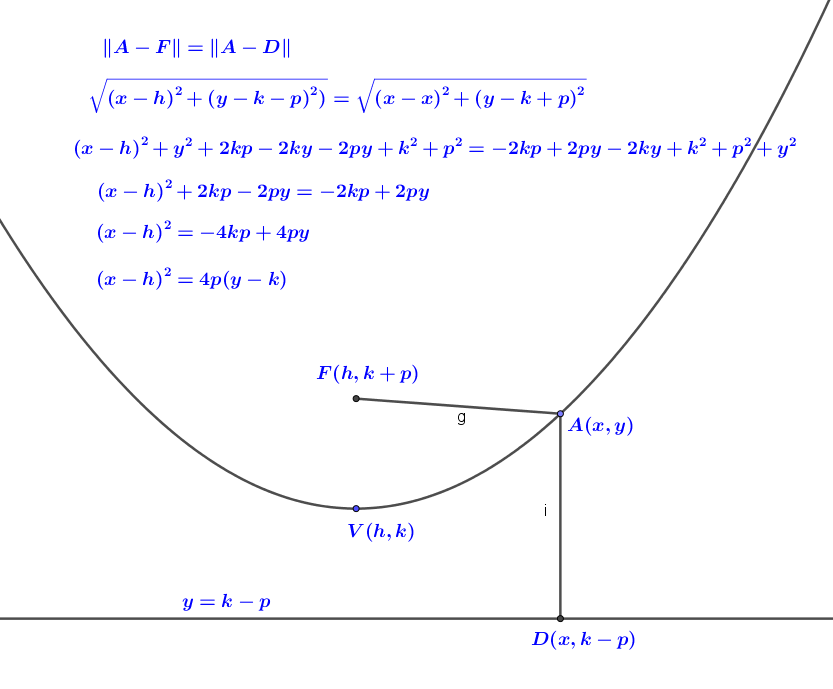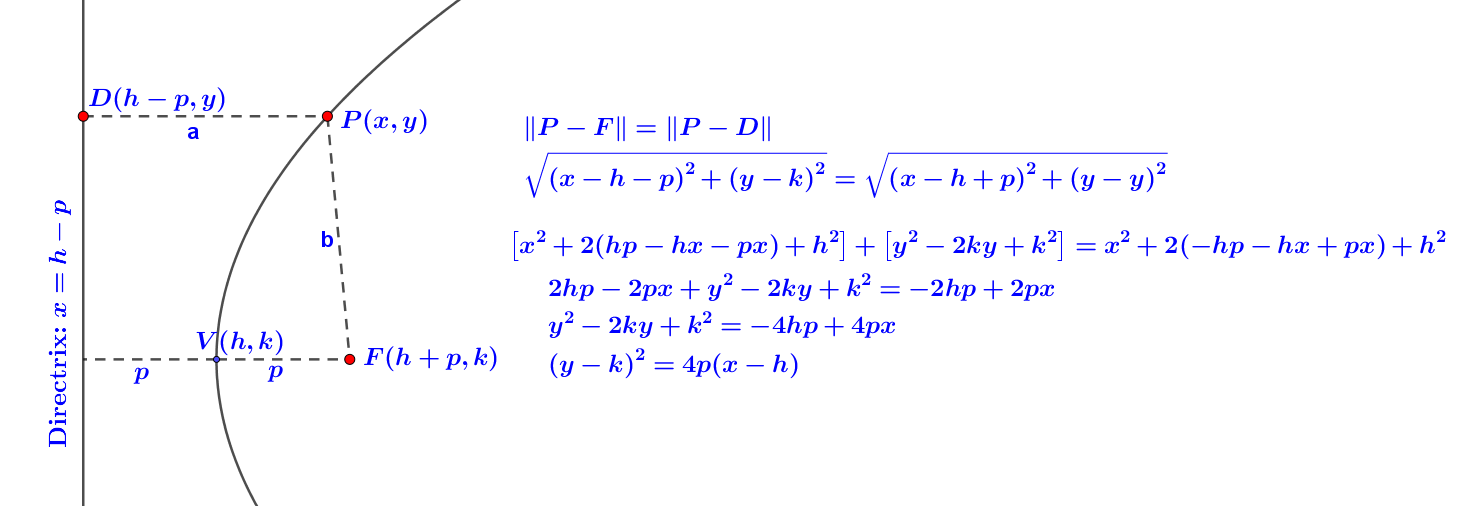Parabola with Vertex at (h,k)
Definition: Parabola. When there exists a Point called the Focus, and line called the Directrix, where that line does not include the Point, then the locus of points which are equal distance from both the Focus and Directrix form a curve that is called a parabola.
Let's work an example parabola problem just using the definition. There are a lot of formulas that you could remember in order to speed this up, but we are going to do this problem without specific parabola formulas.

Example: Given the parabolic equation, $x^{2}+16\;x+18\;y=-91$, find the focal point and directrix.
Answer:
From the definition, we can let the distance, $p$, be from the focal point, $F$, to the vertex, $V$. Also, it is distance, $p$, from the Vertex to the directrix. Let the coordinates of the Vertex be $(h,k)$ and because we have an $x^{2}$ term and no $xy$ term, we are sure that this is a vertical aligned parabola.
The key to solving a parabola is to identify the coordinates of the Focal Point, a point on the curve, and a perpendicular point on the directrix. In this case, we can do that. See figure 1.
Now we will equate the distances and solve for $p$.$$\Vert A-F\Vert=\Vert A-D\Vert$$ $$\sqrt{(x-h)^{2}+(y-(k+p))^{2}}=\sqrt{(x-x)^{2}+(y-(k-p))^{2}}$$ See figure 1 for more algebra details, but when this is unscrambled we get $$(x-h)^{2}=4p(y-k)^{2} \tag{ex1} \label{ex1}$$ Now if we are given a parabola, then with a little work, we can figure out $h$ and $k$ and $p$ and therefore $V(h,k)$ and $F=(h,k+p)$ and the directrix, $y=k-p$. $$f=x^{2}+16\;x+18\;y+91$$ $$x^{2}+16x=-18y-91$$ $$(x+8)^{2}=-18y-91+64$$ $$(x+8)^{2}=-18y-27$$ $$(x+8)^{2}=-18\left(y-\frac{27}{-18}\right) \tag{ex2} \label{ex2} $$ Finally, we have to arrange $\eqref{ex2}$ to really match $\eqref{ex1}$. $$\left(x-(-8)\right)^{2}=4\left(\frac{-9}{2}\right)\left(y-\left(-\frac{3}{2}\right)\right).$$ Now we can see that $h=-8$, $k=-3/2$, and $p=-9/2$. From the figure, $V=(h,k)$, $F=(h,k+p)$ and the directrix is $y=k-p$. Thus our vertex is at ${\color{red}(-8,-1.5).}$ Our focus is $F=(-8,-6)$ and the directrix is $y=3$.
Vertical Aligned Vertex Equation
As long as the parabola is aligned with the vertical axis, meaning it has an $x^{2}$ term and is of the form $y=ax^{2}+bx+c$, we can solve $(x-h)^2=4p(y-k)$ for $y$ and then match coefficients to find the vertex. $$(x-h)^2=4p(y-k)$$ $${\color{red}y=\frac{1}{4p}x^{2}-\frac{h}{2p}x+k+\frac{h^{2}}{4p}}$$ $$a=\frac{1}{4p}\tag{3} \label{3} $$ $$b=\frac{-h}{2p} \tag{4} \label{4}$$ $$c=k+\frac{h^{2}}{4p} \tag{5} \label{5}$$ Solve equations $\eqref{3}$, $\eqref{4}$, and $\eqref{5}$ simultaneously for $h$,$k$,and $p$ to get $$\left(\begin{array}{c} h\\ k\\ p \end{array}\right)=\left(\begin{array}{c} {\displaystyle \frac{-b}{2a}}\\ {\displaystyle \frac{-b^{2}+4ac}{4a}}\\ {\displaystyle \frac{1}{4a}} \end{array}\right)$$ $$\therefore\,V=\left(-\frac{b}{2a},\frac{-b^{2}+4ac}{4a}\right)$$ $$Focus=(h,k+p)=\left(-\frac{b}{2a},\frac{-b^{2}+4ac}{4a}+\frac{1}{4a}\right)$$ $$Directrix:\quad y=k-p=\frac{-b^{2}+4ac}{4a}-\frac{1}{4a}$$
Symbolic Algebra for Vertical Aligned Parabola I
This is all algebra. We will redo section Vertical Aligned Vertex Equation only with a lot of tedium. Just skip this section.
We will start with $y=ax^{2}+bx+c$ and put the equation into standard parabola form: $(x-h)^{2}=4p(y-k)$. $$y=ax^{2}+bx+c$$ Separate the $x$ terms onto the left. $$ax^{2}+bx=y-c$$ Factor the terms on the left. $$a\left(x^{2}+\frac{b}{a}x\right)=y-c$$ Complete the square inside the parenthesis. $$a\left(x^{2}+\frac{b}{a}x+\left(\frac{b}{2a}\right)^{2}\right)$$ Notice that completing the square in that term will require adding a similar term to the right. $$a\left(x^{2}+\frac{b}{a}x+\left(\frac{b}{2a}\right)^{2}\right)=y-c+a\left(\frac{b}{2a}\right)^{2}$$ Rewrite the left term to reflect the squared element. $$a\left(x+\frac{b}{2a}\right)^{2}=y-c+a\left(\frac{b}{2a}\right)^{2}$$ Divide both sides by a. $$\left(x+\frac{b}{2a}\right)^{2}=\frac{1}{a}y-\frac{c}{a}+\frac{a}{a}\left(\frac{b}{2a}\right)^{2}$$ The term on the right side is currently of the form $const\cdot y+konst$ and we need to factor it into $const\cdot\left(y-\frac{konst}{const}\right)$. $$\left(x+\frac{b}{2a}\right)^{2}=\frac{1}{a}\left(y+\frac{-{\displaystyle \frac{c}{a}+\left(\frac{b}{2a}\right)^{2}}}{{\displaystyle \frac{1}{a}}}\right)$$ Multiply the right parenthesis term by $a/a$. $$\left(x+\frac{b}{2a}\right)^{2}=\frac{1}{a}\left(y-c+a\left(\frac{b}{2a}\right)^{2}\right)$$ Expand the right side constant that is inside the parenthesis. $$\left(x+\frac{b}{2a}\right)^{2}=\frac{1}{a}\left(y-c+\frac{ab^{2}}{4a^{2}}\right)$$ Multiply c by $4a/4a$ and cancel the numerator/denominator $a$ on the right. $$\left(x+\frac{b}{2a}\right)^{2}=\frac{1}{a}\left(y-\frac{4a}{4a}c+\frac{b^{2}}{4a}\right).$$ Combine the terms. $$\left(x+\frac{b}{2a}\right)^{2}=\frac{1}{a}\left(y+\frac{b^{2}-4ac}{4a}\right).$$ Change $1/a$ to be $4/4a$. $$\left(x+\frac{b}{2a}\right)^{2}=4\left(\frac{1}{4a}\right)\left(y+\frac{b^{2}-4ac}{4a}\right)$$ Compare to $(x-h)^{2}=4p(y-k)$. OK? Almost, but change the sign inside parenthesis on both sides. $$\left(x-\frac{-b}{2a}\right)^{2}=4\left(\frac{1}{4a}\right)\left(y-\frac{4ac-b^{2}}{4a}\right) \tag{6} \label{6}$$
So equation $\eqref{6}$ shows that if we begin with the form $y=a^{2}+bx+c$, we can transform it into $(x-h)^{2}=4p(y-k)$. $$h=\frac{-b}{2a}$$ $$k=\frac{4ac-b^{2}}{4a}$$ $$p=\frac{1}{4a}$$
Algebra for Vertical Aligned Parabola II
Let's make this as confusing as possible!
Many CAS programs want to express the parabola as $ax^{2}+bx+cy+d=0$. Notice that we just redefined the meaning of variable $c$ and added a new constant, $d$. This time, I am not going to go through the algebra for you, but I will set up the equations as in section Vertical Aligned Vertex Equation.
$$ax^{2}+bx+cy+d=0 \tag{7} \label{7}$$ $$(x-h)^{2}=4p(y-k) \tag{8} \label{8}$$ Solve $\eqref{7}$ for $y$. $$y=-\frac{a}{c}x^{2}-\frac{b}{c}-\frac{d}{c} \tag{9} \label{9}$$ Solve $\eqref{8}$ for $y$. $$y=\frac{1}{4p}x^{2}-\frac{h}{2p}x+k+\frac{h^{2}}{4p} \tag{10} \label{10}$$ Match the coefficients of $\eqref{9}$ and $\eqref{10}$ to make three equations. $$-\frac{a}{c}=\frac{1}{4p} \tag{11} \label{11}$$ $$-\frac{b}{c}=-\frac{h}{2p} \tag{12} \label{12}$$ $$-\frac{d}{c}=k+\frac{h^{2}}{4p} \tag{13} \label{13}$$ Solve $\eqref{11}$, $\eqref{12}$, and $\eqref{13}$ simultaneously to get $${\displaystyle \left(\begin{array}{c} h=-\frac{b}{2a}\\ k=\frac{b^{2}-4ad}{4ac}\\ p=-\frac{c}{4a} \end{array}\right)}$$
Parabola Derivation Open Right
The key to deriving a parabola expression is making a good diagram and identifying coordinates of the points. Begin with a vertex, $V$, and assign it the coordintes $(h,k)$, and pick a point $P$ on the parabola and assign it the coordintes $(x,y)$, Since we want a sideways parabola, we let the directrix be vertical. The parabola definition says that every point is equal distance from the focus, $F$ and the directrix. Therefore, the Vertex is equal distance from $F$ and the directrix. Let's call that distance $p$. Using the assigned coordinates, we can deduce that the coordinates of $F$ are $(h+p,k)$. We can also identify the directrix as the vertical line $x=h-p$. Using the directrix value and the coordinates of $P$, we can identify the coordintes of $D=(h-p,y)$. That concludes the thought process for this derivation. From here on it is just algebra.
Equate the lengths of segments $a$ and $b$ as shown in figure 3 and do the algebra shown in that figure 2 to get $$(y-k)^{2}=4p(x-h) \tag{14} \label{14}.$$

As long as the parabola is aligned with the horizontal axis, meaning it has a $y^{2}$ term and is of the form $x=ay^{2}+by+c$,we can solve $\eqref{14}$ for $y$ and then match coefficients to find the vertex. $$x=\frac{1}{4p}y^{2}-\frac{k}{2p}y+h+\frac{k^{2}}{4p}$$ $$\left(\begin{array}{c} a={\displaystyle \frac{1}{4p}}\\ b={\displaystyle \frac{-k}{2p}}\\ c={\displaystyle h+\frac{k^{2}}{4p}} \end{array}\right)$$ Solve these for h,k,p. $$\left(\begin{array}{c} h={\displaystyle \frac{4ac-b^{2}}{4a}}\\ k={\displaystyle \frac{-b}{2a}}\\ p={\displaystyle \frac{1}{4a}} \end{array}\right)$$ $$\therefore\,V=\left(\frac{-b^{2}+4ac}{4a},-\frac{b}{2a}\right)$$